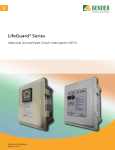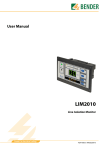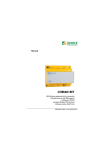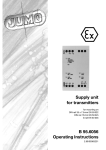Download Technical Bulletin / Datasheet: MarinaGuard Series
Transcript
TM MarinaGuard Series Ground Fault Monitoring Panel For Marina Shore Power Technical Bulletin NAE1092812 / 04.2013 BENDER Inc. • 700 Fox Chase, Coatesville PA 19320 • Ph: 800-356-4266 / 610-383-9200 • Fax: 610-383-7100 MarinaGuard Series Ground Fault Monitoring Panel Ground Fault Monitoring Panel For Marina Shore Power Description MarinaGuard series panels detect ground faults for shore power in marinas. Options are available for monitoring either main feeders or branch circuits. The MarinaGuard satisfies the new requirements in the 2011 National Electrical Code, article 555.3, "Ground-Fault Protection." All models may be set to 100 mA for feeder protection, and may be set lower if desired. Models for monitoring branch circuits may be steplessly adjustable down to 6 mA. All models feature a NEMA 4X rated enclosure, with test and reset buttons, power and alarm LEDs, and a strobe light on the top of the enclosure for clear indication if a fault has occured. Applications • Shore power for marinas MarinaGuard series panel • Feeder and branch monitoring • Systems which must satisfy the requirements of NEC 2011, Article 555.3 Features • Satisfies requirements of NEC article 555.3, "Ground-Fault Protection" • Ground fault monitoring for marinas • Options for single feeder monitoring and branch monitoring • Preset to 100 mA trip level, steplessly ad- justable down to 10 mA for feeder pro- tection, 6 mA for branch protection • TEST and RESET pushbuttons on front • POWER and TRIPPED LEDs on front • Strobe light for easily visible alarm indication • Contact outputs for remote notification or connection to a feeder shunt trip breaker • NEMA 4X rated, lockable enclosure • Option for SMS alarm messaging to cell phones • Multi-channel versions support connec tion to BENDER communication gate- ways to standard protocols such as Modbus/TCP 2 Function MarinaGuard panels detect faults by means of current transformers (CTs). One CT is required per feeder or branch to be monitored (see ordering information). Each feeder / branch will have all conductors going through the current transformer. For example, in 240/120 V shore power applications, both hot conductors as well as the neutral must be placed through the current transformer. If a ground fault is detected, the connected MarinaGuard will activate an alarm. The Fault Alarm light on the front of the enclosure will illuminate, and the strobe light will activate. For the branch protection model, a fault on any branch will activate the LED and strobe light. Once the fault or faults have been cleared, holding the reset button for at least 2 seconds will clear the alarm lights and return the panel to the normal state. Each model features dry contact outputs, which may be used for remote notification to a harbor master's office. The dry contacts may also be used to connect to a feeder shunt trip breaker, if interruption is desired. The "C" option is available for all model types, which allows for wireless SMS alarm messaging to cell phones when an alarm has activated. Additionally, MG-S and MG-T branch protection models features compatibility with BENDER's digital communication system, which may be used to integrate with Ethernet and Modbus/TCP networks. MarinaGuard Panel Front (Example shown: MG-1, MG-S, MG-T) MG-2 and MG-3 versions have one set of ON/ALARM lights and TEST/RESET buttons per monitor (2 total for MG-2, 3 total for MG3). 3 1 - POWER ON LED / TEST pushbutton: Illuminates when power is applied and no alarms are present. Pushing the button ini tiates a self-test of the monitor. 2 -ALARM LED / RESET pushbutton: Illuminates when one or more alarms are detected. Holding the button for at least 2 seconds will reset the device if alarms have been cleared. 3 - Strobe Light: Illuminates when any alarms are detected. Strobe ON indicates Ground Fault Ground Fault Monitor Monitor ON Push to Test Ordering Information: Current Transformers Name W0-S20 W1-S35 W2-S70 W3-S105 W4-S140 W5-S210 Inside diameter Ordering no. ø 0.75" (20 mm) ø 1.4" (35 mm) ø 2.4" (60 mm) ø 4.1" (105 mm) ø 5.5" (140 mm) ø 8.25" (210 mm) B 911 787 B 911 731 B 911 732 B 911 733 B 911 734 B 911 735 Fault Alarm Push to Reset 1 2 Support: 800-356-4266 One current transformer is required per feeder / branch. Ordering Information: MarinaGuard Name Quantity of feeders / branches Adjustable trip level Number of contact outputs Supports COM460IP Communication Gateway SMS Alarm Messaging Support MG-1 MG-2 MG-3 MG-S 1 2 3 12 10 mA - 10 A 10 mA - 10 A 10 mA - 10 A 6 mA - 20 A 1 individual 2 individual 3 individual 1 common No No No Yes No No No No MG-T 12 6 mA - 20 A 1 common, 12 individual Yes No MG-1C 1 10 mA - 10 A 1 individual No Yes MG-2C 2 10 mA - 10 A 2 individual No Yes MG-3C 3 10 mA - 10 A 3 individual No Yes MG-SC 12 6 mA - 20 A 1 common Yes Yes MG-TC 12 6 mA - 20 A 1 common, 12 individual Yes Yes 3 Option "C" - Wireless text messaging of alarms to cell phones Option C includes a built-in module which allows for SMS messaging to technicians / harbor masters when an alarm is activated. The system is wireless and uses a SIM card for messaging (SIM card and SMS service sold separately). Alarm notifications and technician phone numbers are customizable. Multiple phone numbers may be set to simultaneously receive alarm text messages. Most settings are preconfigured at the factory and very little field adjustments are required. A PLC and connected GSM module are used to control the alarm notification. All MarinaGuard models support the "C" option. 4 MG-S and MG-T models: Connection to BENDER's communication bus TCP/IP Modbus/TCP Modbus/TCP SCADA / BMS Ethernet Modbus/TCP COM460IP BENDER Communication Bus Strobe ON indicates Ground Fault Strobe ON indicates Ground Fault Ground Fault Monitor Ground Fault Monitor Monitor ON Push to Test Fault Alarm Push to Reset Support: 800-356-4266 Monitor ON Push to Test Fault Alarm Push to Reset Support: 800-356-4266 MG-S and MG-T multi-channel models support connecting to BENDER's advanced communication bus for remote notification of alarms on shore power. When connecting to the COM460IP communication module, status of MarinaGuard panels may be viewed remotely at a master station via a standard Ethernet network or Modbus/TCP fieldbus communication. When using an Ethernet network, mobile devices connected wirelessly to the network can view the status of MarinaGuard panels using a special mobile version. BENDER's communication network supports connecting to other BENDER devices as well, including the MK2430 remote indicating station, which manages the status of multiple connected devices from a single remote. 5 Wiring • All MarinaGuard models require a 120 VAC supply voltage. Connect L to the designated terminal block, and N to the terminal on the enclosed ground fault monitor labeled "A2." • Connect the current transformer(s) per the appropriate schematic below. For models which support more than one current transformer, connect to the appropriate K/L terminal. Use minimum AWG 24, maximum AWG 12 THHN wire. • All models have contact outputs which may be used for remote notification. Refer to the appropriate schematic below for the normally open or normally closed contact to connect to. Example Wiring - MG-1 Example Wiring - MG-S Cust. Connection 120 VAC Aux Supply Cust. Connection 120 VAC Aux Supply N L N L Cust. Connection GROUND Cust. Connection GROUND l - Row Current Transformer 120 VAC N/O For External Alarm 1/2 5/6 3/4 120 VAC N/O For External Alarm 1 2 3 4 5 6 7 8 9 10 11 12 To External 120VAC N/O Alarm, Contactor, Shunt Trip, Etc. External Current Transformer(s) Monitoring Feeder(s) / Branch(es) Repeat For All Channels 123 4 123 4 6 k- Row Current Transformer L N L N External Current Transformer Monitoring Feeder / Branch 9/10 11/12 7/8 To External 120VAC N/O Alarm, Contactor, Shunt Trip, Etc. Wiring - Current Transformer Placement in a Typical Shore Power Application Each monitored feeder or branch requires one current transformer. The current transformer must be large enough to have all conductors passing through it. Position 1 (before the primary MCB) and position 2 (between the primary MCB and branch CBs) are recommended placements for feeder monitoring, and typically used with MG-1, MG-2, and MG-3 MarinaGuard models. Position 3 (individual branches) is for branch monitoring, and is recommended with MG-S and MG-T series MarinaGuard panels. 240/120V Grounded Neutral Supply Transformer Current Transformer (CT) Position 1 Primary Main Circuit Breaker Current Transformer (CT) Position 2 Power Distribution Main Circuit Breaker Branch Circuit Breakers Strobe ON indicates Ground Fault Ground Fault Monitor Monitor ON Push to Test Fault Alarm Push to Reset Support: 800-356-4266 Current Transformer (CT) Position 3 Shore Power Pedestal Receptacle Circuit Breaker Receptacle 7 Post-Installation Adjustments In most applications, changing settings on enclosed ground fault monitors is not necessary. However, should changes be required, refer to the respective devices below. MG-1, MG-2, and MG-3 Series MarinaGuard Panels Settings for MG-1, MG-2, and MG-3 panels are changed on the enclosed ground fault monitor with DIP switches and potentiometers. 2 3 4 7 8 9 } 1 10 A B C D E F 5 6 1 -Combined TEST and RESET button: short depress (< 1s) = RESET; long depress (> 2s) = TEST 2 -Power On LED 3 -Alarm LED: Illuminates when the response value has been exceeded. Flashes when the CT connection alarm is active. 4 -LED bar graph indicator: shows the measuring value in percent of the preset response value. 5 -Potentiometer for setting the response delay (0…1 s). 6 -Potentiometer for setting the response value (x 1…10 mA) DIP switch settings (white = switch position) 7 - Alarm relay operation settings A - Normally de energized B -Normally energized 8 - Fault memory / latching behavior settings A - Fault memory ON (latching mode) B - Fault memory OFF (non-latching mode) 9 -Sample response value settings A - 10 mA B - 30 mA C - 100 mA x 1…10 D - 300 mA E - 500 mA F - 1000 mA 10 -Time delay settings A - x 1 0…1 s B - x 10 } } MG-S and MG-T Series MarinaGuard Panels MG-S and MG-T series panels utilize a digital display with built-in menu to make settings changes. Refer to MarinaGuard User Manual (NAE1095810) for information on changing available settings. 8 How Does a MarinaGuard Detect Ground Faults? In a typical shore power application, the secondary of the shore power transformer provides grounded 240/120 VAC power. When monitoring the feeder, the MarinaGuard will be connected to a current transformer. The current transformer will be placed around both hot conductors and the neutral (the ground conductor is not placed through). The MarinaGuard will detect faults downstream of the current transformer, including any leakage current between the transformer and wiring to the pedestals, or to a connected boat. Ground faults are detected by looking for a net imbalance of current between the phases - this correleates to an equivalent amount of leakage current downstream. Branch monitoring works in a similar manner, however each individual branch leading to the pedestals is monitored seperately. Notification can be provided as to the particular branch that has the ground fault. Shore power supply MarinaGuard Pedestal Ground Possible ground fault paths in a shore power application Locating Ground Faults - MG-S / MG-T Series MarinaGuard Panels If an MG-S or MG-T series MarinaGuard is being used for branch detection, fault location will be done automatically. The display of the enclosed ground fault monitor will indicate which branch has the fault. The screen will also display how much leakage current was detected. MG-T models additionally feature individual contact outputs for each branch, which may be used for remote notification or branch interruption via a device such as a shunt trip breaker. ALARM 1/1 Residual current 130 mA Addr.: 2 Chan.: 12 ( Digital display of MG-S /MG-T ground fault monitor displaying a ground fault on branch 12 Locating Ground Faults - MG-1, MG-2, and MG-3 Series MarinaGuard Panels If an MG-1, MG-2, or MG-3 is being used for feeder protection, several options are available for locating faults: • Shutting off individual branch breakers until pressing the RESET button on the front of the panel resets the system back to the normal condition • Using a low-mA, clamp-on ammeter to clamp around individual shore cords. A clamp-on ammeter must have all conductors going through the clamp-on current transformer. 9 Enclosure Dimensions (All Models) Dimensions listed in inches 12.750 10.250 F .150 TOP .140 TOP R.375 6.375 5.125 2.563 .590 2.563 .885 2.813 13.405 5.0 ° .150 60.0 ° 5.828 4.125 6.480 2.063 .500 10.750 6.140 2.063 .800 TOP .425 TOP .438 F .566 SEE DETAIL A Document NAE1092812 / 04.2013 / © Bender Inc. 5.125 TM USA • Coatesville, PA Toll-Free: 800-356-4266 • Main: 610-383-9200 Fax: 610-383-7100 • E-mail: [email protected] Canada • Mississauga, ON Toll-Free: 800-243-2438 • Main: 905-602-9990 Fax: 905-602-9960 • E-mail: [email protected] bender.org • bender.org/mobile





















